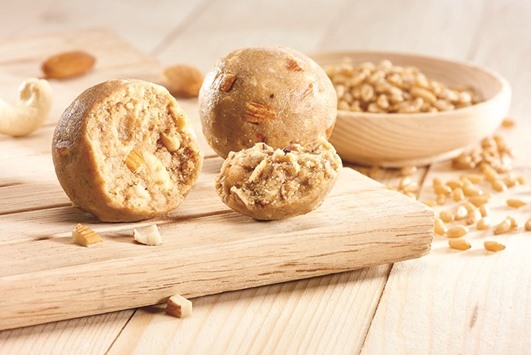As we move into November we all are delighted to welcome winters and today I’ll tell you about a humble yet special food item that can be easily prepared beforehand and is an ideal energy food item to start the day.
I always keep some of these handy for a quick petite breakfast, especially during the winters. You can also feed this to your kids along with a glass of milk for a nutritious start to the day.
The food item is ladoo – yes I would call ladoo as Indian national sweet dish owing to its popularity and the versatile ways in which it can be prepared. Ladoo is an omnipresent sweet and it secures its place in every Indian festival and its mention is enough to bring a smile to one’s face.
You can easily spot a different variety in each Indian state with its own recipe depending on the raw materials present in that region, weather conditions and local taste preferences. For example, you will easily spot coconut ladoos in south Indian sweet shops, besan ladoos in North Indian sweet shops, atta ladoos in Rajasthan and channa ladoos in Kolkata.
It is noteworthy to know that ladoos were originally created for their medicinal properties, but later on other varieties were made that are now so popular that sweet shops rely on them for their sales and profits. One of the main reasons for their popularity is their long shelf life due to which they could be prepared beforehand and stored for long durations and transported long distances. Their evolution has been a sweet journey, with sesame ladoos, jaggery ladoos, fig ladoos, almond ladoos, dates ladoos, boondi ladoos and besan ladoos to name but a few.
A fable from Eastern India claims that ladoos came into being when a vaid (an ancient doctor) poured more clarified butter than the medicine needed. The vaid ended up creating small, round balls and giving them to patients. This became popular, as the method of medicine delivery was convenient both for patients and the vaids.
One famous ladoo from Kanpur is called thaggu ke ladoo. This delicate sweet got its name from the white sugar used in it to sweeten it. The white sugar was initially known as white poison in India and thus the name thaggu ke ladoo meaning ladoo for the cheat became synonymous. Unable to remove the sugar from the ladoo, the creator named it “thaggu ke ladoo”.
My favourite, the besan ladoo, is quite popular and is common during celebrations, festivals and weddings. In India it is common to present this with the wedding card to mark the celebrations and share happiness with friends and family.
There are usually four main parts of ladoo recipe. The first is the main ingredient, which gives the ladoo its name, such as besan (gram flour), atta, and coconut etc. The second ingredient is the sweetener, which could be sugar, jaggery, or cane sugar etc. The third ingredient is the fat, which is usually added in the form of desi ghee or clarified butter. The last ingredient is the flavouring, which can be cardamom, cashew nuts, pistachio or almonds, or a combination of some of these.
The fact that besan ladoo uses more gram flour than clarified butter makes it a healthier than many, and makes it an idea food item to start your cold winter mornings or curb your late night snack carvings.
Atta Ladoo
Ingredients
Whole wheat flour 1 cup
Semolina 1 tbsp
Clarified butter 1 cup
Sugar, coarse ¾ cup
Almonds, crushed 1/3 cup
Cardamom powder ¼ tsp
Salt a pinch
Cinnamon powder a pinch
Method
Sieve the flour and semolina and dry roast over medium heat until the colour changes to brown (approx. 8 minutes).
Add crushed almonds and roast for 3 more minutes, keep stirring to avoid burning the flour.
Add clarified butter and continue to stir, the flour will turn brown and the raw smell will disappear (approx. 5-8 minutes).
Remove from heat and allow the mixture to cool down for 10 minutes.
Add sugar and cardamom powder and mix well until the sugar is dissolved well in the mixture.
Allow the mixture to cool down a bit so that you can hold the mixture in your hands.
Take about 2tbsp of the prepared mixture and gently press between your palms to form a smooth, round ball.
Repeat until the entire mixture has been shaped into ladoos.
You can heat up the ladoo just before consuming in microwave for about 10 seconds to enjoy a warm and delicious ladoo.
Note: the size of the ladoos should be smaller than the golf ball. You can also add more dry fruit according to your preference. Adding semolina makes your ladoos crunchier and delicious.
* Chef Tarun Kapoor,
Culinary Mastermind, USA. He may be contacted at [email protected]

Atta Ladoo. Photo by Chef Tarun Kapoor


